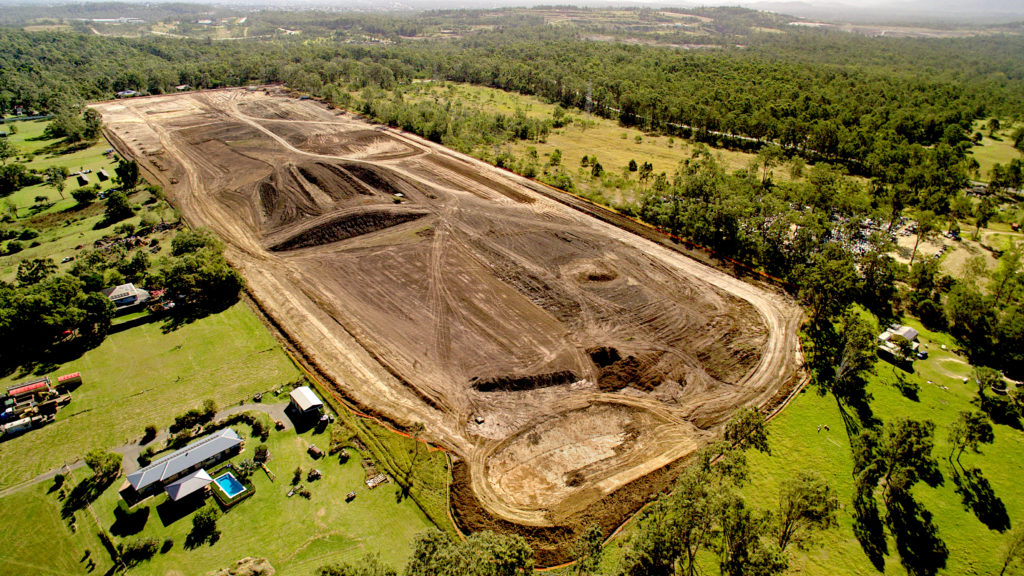It is difficult to drive around anywhere and not notice construction occurring somewhere. In addition to government roadway projects, you may have noticed in particular many construction projects involving the moving of earth and the construction of buildings on private parcels of land. This type of construction is commonly referred to as land development.
Land development is the physical and man-made alteration of the earth for the purpose of constructing new buildings, driveways, roads, parking lots, walls, walkways, recreational fields, open space areas, stormwater management systems, and associated utilities required to use any proposed buildings.
Land development can involve projects that are residential, industrial, or commercial and the utilities that can be a part of land development include the proposed water supply, sanitary sewer system, electric line connections, and gas line connections. Also, land development can refer to both public and private construction projects.
A major part of a land development is knowing and managing the amount of any new impervious area that is proposed. Impervious area, as it relates to land development, is usually defined as any area that is, for the most part, impermeable to water after a rainfall event. In other words, it is an area where all or most of the rain water (also known as stormwater runoff) will flow off of and away from the area until the runoff reaches a non-impervious area during and after a rain event.
Examples of impervious areas include buildings, decks, driveways, roads, parking lots, curbs, and sidewalks.
Non-impervious areas such as grass, meadow, and woodland areas would (up to a point) absorb much of the runoff generated from any given rain event.
Another thing to note is that a land development could be proposed for just one lot or it could be proposed for a major subdivision that has many proposed lots. However, even though it could be argued that land development could be for any significant alteration of land, there are municipalities that have a specific definition for “land development” based on the type of construction being proposed or the number of lots being proposed.
Whether or not the site meets the definition of “land development” for the municipality could affect the cost of the design of your project and the length of time it could take to have your plan be approved and ready for construction.
Why Is Impervious Area a Major Component of Land Development?
The amount of proposed impervious area is important to those municipalities who have to review and approve proposed land development designs. The words “impervious area” or “impervious coverage” are very familiar to land developers and civil engineers who regularly work on land development projects.
Related: What Is Impervious Area in Land Development?
The reason is because a common government regulation with regard to land development is the amount of impervious area that is normally allowed by law. For example, if a zoning ordinance states that a maximum impervious coverage allowed for a proposed commercial land development on a lot is 30%, then the remaining 70% of the lot would have to be some combination of grass, open space, meadow, and woods.
Limiting the amount of proposed impervious area is important because not only could having too much impervious area on a lot to be developed have a negative effect on the look of the lot and the surrounding properties but also an excessive amount of impervious area could make the design for stormwater management more difficult since much of a stormwater management design is dependent on the increase in impervious cover from the pre-development condition of a site to the post-development condition after construction of the proposed land development.
When there is a proposed increase in impervious area, there is also a corresponding increase in stormwater runoff that usually has to be collected, treated, and controlled before it can leave the site. Therefore, the greater the proposed impervious area for a land development, the greater the area of the site that would have to be used for stormwater management.
Advertisement
The People Involved With a Land Development Project
If you ever decide to proceed with having a land development plan created for your property, there are many different kinds of people that you may have to work with to get your project started, designed, approved, and finally built.
The following are just a few of these kinds of people.
1) Surveyors – Surveyors will be required to develop a base survey plan with which to start your project.
Related: What a Land Surveyor Does and Why It Is Important
2) Civil Engineers – Civil engineers are the professionals that would design your land development plan.
Related: What Is a Land Development Engineer?
3) Municipal Officials and Reviewers – Depending on the municipality where your site is located, your project will have to be reviewed and approved for compliance with various zoning and design requirements. The municipal reviewers could include zoning officers, review engineers, and even groups of officials who meet every month to review proposed land development plans.
4) Outside Government Agencies – Depending on your site conditions, you (perhaps through your hired civil engineer) may have to deal with other state and federal government agencies (such as your state department of transportation and the Federal Emergency Management Agency) to obtain certain other permits and approvals that would be required for your construction to start.
5) Recorder of Deeds Officials – If required by the municipality of your site, you may have to visit the local Recorder of Deeds office in order to record your approved plans.
6) Site Contractors – These would be the people who would eventually construct what has been designed for your site. Site contractors would include general contractors, excavators, pavers, utility installers, and landscapers.
The above list of people applies to the construction of just the site work. The site work is the part of the construction outside of the building areas. There are still many others you may have to work with to complete the building portion of your construction. These others could include building architects, various engineers involved with the design of the structure and the interior components of your buildings, and building inspectors.
What Is a Land Development Plan?
A land development project requires a land development plan which is a construction plan that shows what is necessary to construct the site work for a project and that would usually show any proposed building footprints without showing what is proposed for the interior of the buildings.
As stated previously, site work would be all of the proposed work you would see outside of the buildings and could include, but is not limited to, driveways, parking areas, walls, stormwater management systems, and general grading.
With regard to any proposed buildings, a land development plan would mainly show where the buildings are to be located on the site. This plan might also show the general areas where utilities are to be connected to the buildings. Separate construction plans (such as architectural plans) would be used to construct the actual buildings.
There are times when land development plans might also be referred to as “site plans”, “grading plans”, or even “stormwater management” plans” especially if you are dealing with small proposed projects.
Related: The Parts of a Land Development Plan
Steps to Creating a Land Development Plan
The following is a general summary of the major steps involved with creating a land development plan that can be used for construction.
1) Create a base survey that shows existing conditions for the site.
2) Create a land development plan set that shows all proposed paving, buildings and other structures, utility connections, stormwater management systems, lighting, and landscaping.
3) Submit the proposed plans and design calculations to the municipality, where the site is located, and any other applicable reviewing agencies for review.
4) Revise the plans and calculations as required per the various reviews.
5) Obtain all necessary permits and approvals.
6) Have the plans recorded at the local Recorder of Deeds as required.
Because of how complicated the land development design process can be, you would most likely have to hire a civil engineering company to prepare all of the necessary plans, engineering reports, and applications to be submitted for the various reviews and approvals.
Advertisement
How Much to Expect to Pay for a Land Development Plan
The costs involved with creating a land development plan will vary greatly depending on many factors including the municipality within which your site is located, the civil engineer you choose to hire, and the size of your site.
The total cost to create a land development plan could range anywhere from $1,500 to $50,000 if not more.
Also keep in mind all of the other costs related to construction to consider. These costs could include architect fees, municipality application and review fees, site construction costs, and building construction costs. You will soon discover that the cost of having a land development plan created is just a small portion of all the costs you would have to incur for the construction of a land development project.
Related: 10 Common Costs of a Land Development Project
Land Development Is a Complex Topic
As you can see, land development is a very complicated topic with many different pieces that have to be designed and coordinated. Unless you are a licensed civil engineer and a licensed surveyor yourself, any interest in land development would most likely require some outside professional help.
Related: Recommendations for Land Development Books
Related: Recommendations for Site Design Books
Related: Recommendations for Site Planning Books



